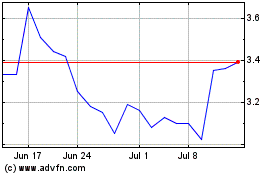Minerva Neurosciences Presents Pre-Clinical Data Suggesting a Mechanistic Role of Roluperidone in Addressing Negative Symptom...
April 11 2019 - 8:30AM

Findings show roluperidone increases
release and gene expression of BDNF, as well as release of
GDNF
Minerva Neurosciences, Inc. (NASDAQ: NERV), a clinical-stage
biopharmaceutical company focused on the development of therapies
to treat central nervous system (CNS) disorders, today announced
the presentation of a poster at the 2019 Congress of the
Schizophrenia International Research Society in Orlando, Florida
entitled Roluperidone increases in-vitro Brain-Derived Neurotrophic
Factor (BDNF) release: a possible mechanistic role in negative
symptoms?
Findings to be presented in Poster #T145 during Poster Session 1
on April 11, 2019, 12:00 p.m. – 2:00 p.m., demonstrate that
administration of roluperidone significantly increased BDNF release
by astrocytes and hippocampal neurons obtained from the cerebral
cortex of newborn rats, as well as the release of GDNF (Glial cell
derived neurotrophic factor) in cultured astrocytes.
Furthermore, data showed that roluperidone enhanced BDNF gene
expression at drug concentrations similar to those observed in
humans at tested doses.
Based on these results, researchers suggested that the effect of
roluperidone on BDNF and GDNF may indicate the potential of this
investigational compound for disease modification and improved
neuroplasticity, in addition to its observed effects on the sigma2
and serotoninergic 5-HT2A neurotransmitter pathways.
BDNF is a member of a family of proteins called neurotrophins
that plays an important role in the formation and function of
neural connections. BDNF is the most widely distributed
neurotrophin in the brain and has been associated with
neurogenesis, neuroplasticity, neuroprotection, synapse regulation,
learning, and memory.1 Its involvement in schizophrenia has
also been described.2 GDNF is another neurotrophin that is
known to promote the survival of different types of brain cells and
has been shown to be essential for the maintenance and survival of
dopamine neurons.3
About Roluperidone
Roluperidone is a drug candidate with equipotent affinities for
5‑hydroxytryptamine-2A (5-HT2A) and sigma2 and at lower affinity
levels, α1-adrenergic receptors. Roluperidone exhibits no affinity
for dopaminergic, muscarinic, cholinergic and histaminergic
receptors. Roluperidone has no direct dopaminergic
post-synaptic blocking effects, known to be involved in some side
effects like extrapyramidal symptoms, sedation, prolactin increases
and weight gain.
A pivotal Phase 3 clinical trial is ongoing with roluperidone as
monotherapy for negative symptoms in patients diagnosed with
schizophrenia. Approximately 500 patients are expected to be
enrolled at approximately 60 clinical sites in the U.S. and
Europe. Top-line results from the 12-week double blind phase
of this trial are expected in mid-2019.
About Minerva Neurosciences:
Minerva Neurosciences, Inc. is a clinical-stage
biopharmaceutical company focused on the development and
commercialization of a portfolio of product candidates to treat CNS
diseases. Minerva’s proprietary compounds include:
roluperidone (MIN-101), in clinical development for schizophrenia;
MIN-117, in clinical development for major depressive disorder
(MDD); seltorexant (MIN-202 or JNJ-42847922), in clinical
development for insomnia and MDD; and MIN-301, in pre-clinical
development for Parkinson’s disease. Minerva’s common stock
is listed on the NASDAQ Global Market under the symbol
“NERV.” For more information, please visit
www.minervaneurosciences.com.
Forward-Looking Safe Harbor Statement
This press release contains forward-looking statements which are
subject to the safe harbor provisions of the Private Securities
Litigation Reform Act of 1995, as amended. Forward-looking
statements are statements that are not historical facts, reflect
management’s expectations as of the date of this press release, and
involve certain risks and uncertainties. Forward-looking
statements include statements herein with respect to the timing and
scope of future clinical trials and results of clinical trials with
roluperidone, seltorexant, MIN-117 and MIN-301; the timing and
scope of future clinical trials and results of clinical trials with
these compounds; the clinical and therapeutic potential of these
compounds; the timing and outcomes of future interactions with U.S.
and foreign regulatory bodies; our ability to successfully develop
and commercialize our therapeutic products; the sufficiency of our
current cash position to fund our operations; and management’s
ability to successfully achieve its goals. These
forward-looking statements are based on our current expectations
and may differ materially from actual results due to a variety of
factors including, without limitation, whether roluperidone,
seltorexant, MIN-117 and MIN-301 will advance further in the
clinical trials process and whether and when, if at all, they will
receive final approval from the U.S. Food and Drug Administration
or equivalent foreign regulatory agencies and for which
indications; whether any of our therapeutic products will be
successfully marketed if approved; whether any of our therapeutic
product discovery and development efforts will be successful;
management’s ability to successfully achieve its goals; our ability
to raise additional capital to fund our operations on terms
acceptable to us; and general economic conditions. These and
other potential risks and uncertainties that could cause actual
results to differ from the results predicted are more fully
detailed under the caption “Risk Factors” in our filings with the
Securities and Exchange Commission, including our Annual Report on
Form 10-K for the year ended December 31, 2018, filed with
the Securities and Exchange Commission on March 12,
2019. Copies of reports filed with the SEC are
posted on our website at www.minervaneurosciences.com. The
forward-looking statements in this press release are based on
information available to us as of the date hereof, and we disclaim
any obligation to update any forward-looking statements, except as
required by law.
| Contact: |
| William B. Boni |
| VP, Investor Relations / Corp.
Communications |
| Minerva Neurosciences, Inc. |
| (617) 600-7376 |
1 BDNF and schizophrenia: from neurodevelopment to neuronal
plasticity, learning and memory, R. Nieto et al, Frontiers in
Psychiatry, June 2013, Volume 4 Article 45,
https://doi.org/10.3389/fpsyt.2013.00045
2 Childhood trauma interacted with BDNF Val66Met influence
schizophrenic symptoms, Xiao-jiao Bi et al, Medicine,
http://dx.doi.org/10.1097/MD.0000000000010160
3 ScienceDirect,
https://www.sciencedirect.com/topics/biochemistry-genetics-and-molecular-biology/glial-cell-line-derived-neurotrophic-factor
Minerva Neurosciences (NASDAQ:NERV)
Historical Stock Chart
From Mar 2024 to Apr 2024

Minerva Neurosciences (NASDAQ:NERV)
Historical Stock Chart
From Apr 2023 to Apr 2024
